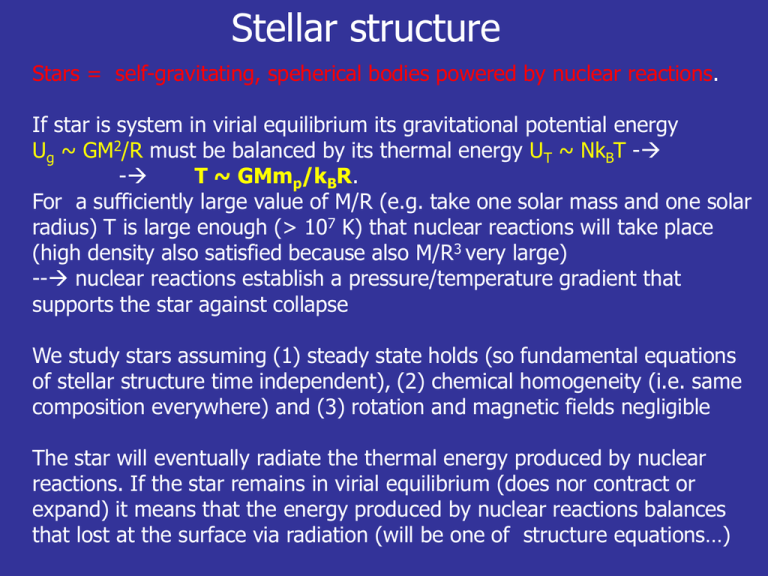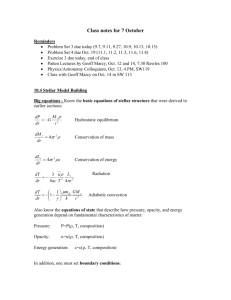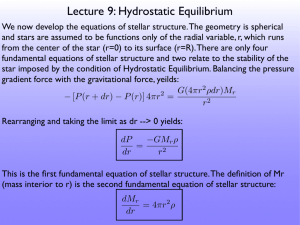Stellar structure
advertisement

Stellar structure Stars = self-gravitating, speherical bodies powered by nuclear reactions. If star is system in virial equilibrium its gravitational potential energy Ug ~ GM2/R must be balanced by its thermal energy UT ~ NkBT - - T ~ GMmp/kBR. For a sufficiently large value of M/R (e.g. take one solar mass and one solar radius) T is large enough (> 107 K) that nuclear reactions will take place (high density also satisfied because also M/R3 very large) -- nuclear reactions establish a pressure/temperature gradient that supports the star against collapse We study stars assuming (1) steady state holds (so fundamental equations of stellar structure time independent), (2) chemical homogeneity (i.e. same composition everywhere) and (3) rotation and magnetic fields negligible The star will eventually radiate the thermal energy produced by nuclear reactions. If the star remains in virial equilibrium (does nor contract or expand) it means that the energy produced by nuclear reactions balances that lost at the surface via radiation (will be one of structure equations…) Equations of stellar structure - I The first three equations of stellar structure are trivial: (1)Hydrostatic equilibrium 1/r x grad(P)= -grad(f) dP/dr = -GM(r) r(r)/r2 (2)Conservation of mass dM(r)/dr = 4pr2r (3) Equation of state (ideal gas + photons) P=P(r, T ) in general (will reduce to barotropic equation of state P=P(r) for white dwarfs/neutron stars) P = rkBT/mmH + 1/3aT4 a = 4s/c (radiative constant) Composition determines equation of state through value of m. Assuming (1)Fully ionized gas (ok because collisional ionization efficient at high r) (2) X+Y+Z = 1, X, Y, Z = mass fractions of hydrogen, helium and metals and (3) Z << X, Y ~ 1 – X, X ~ 0.71 -- m ~ 0.5 X -0.57 ~ 0.6 Note: discarding metals would be perfectly right for the first generation of stars that formed at high redshift in the first galaxies. These stars, called Population III stars, formed from the collapse of metal-free molecular clouds with primordial composition (X ~ 0.75, Y ~ 0.25, from the Big Bang because metals were first synthesized by massive stars via nuclear reactions in their interior and then released as they explode as supernovae. Without metals cooling is inefficient (recall carbon and oxygen crucial to cool ISM) so cloud collapse when they are still massive because Jeans mass high- first stars were massive (M > 10 Mo) and therefore exploded as supernovae. Today’s Pop I stars (e.g, the Sun) have X ~ 0.71, Y ~ 0.27, Z ~ 0.02 (measured) and Pop II stars (in stellar halo and globular clusters) slightly more metal poor. We now have three equations for four variables M(r), r(r), P(r) and T(r). We need one more equation giving T(r). This will depend on what is the process that transports thermal energy from the center to the surface of the star. There are two possibilities and they will be more or less important in (1) different regions of the same star and (2) stars of different masses; (1) Radiation (2)Convection Equations of stellar structure – II Radiation and convection Radiation Stars have very hig-h densities in their interior so t > > 1. The energy flux due to radiation can be calculated using the diffusion approximation: F(r) = L(r)/4pr2 = - 4acT3/3rk(r) x dT/dr dT/dr = - 3k(r)r L(r)/(16acT3pr2) One needs the auxiliary opacity function k(r). For a fully ionized gas this is easy to calculate since the opacity is the combination of just a few processes. Their relative importance will vary as function of distance from the center because some of the opacity sources are function of r, T + all depend on the composition of the star; Kes = 0.2 (1 + X) cm2g1 electron/photon scattering (Thomson/Compton) Kbf ~ 4 x 1025 cm2g-1 Z(1 + X)rT-3.5 cm2/g-1 absorption of electron by atom/ion Kff ~ 4 X 1022 (X+Y)(1+X)rT-3.5 cm2g-1 absorption of photon by free electron kH- ~ 2.5 x 10-31(Z/0.02)r1/2T9 (inverse brehmsstrahlung) absorption of photon by H3000 K < T < 6000 k – envelope) (important at Convection The star will be convectively unstable in regions where dlnT/dlnP > (g – 1)/g, where (g-1)/g is the temp. gradient expected in an adiabatic gas (4/3 < g < 5/3) depending on degrees of freedom f of atoms/molecules/ions, g = ((f+2)/f) The conditions of the gas in the star will not be adiabatic in general because the star is losing energy via radiation. We can write dlnT/dlnP = P/T(dT/dr/dP/dr) - if radiative losses create a rapid variation of temperature with radius (i.e steep dT/dr) convection becomes important. Hence it is radiation that establishes the gradient. Since there is no general theory of convective energy transport that works in all regimes (i.e. for arbitrary convective fluxes) we will assume the maximum possible convective flux is establshed as soon as convection starts --- this implies that the gradient will tend to reach the adiabatic value because convection is efficient, hence: dlnT/dlnP = P/T(dT/dr/dP/dr) = (using hydrotsatic equilibrium equation for dP/dr) = -r2/GM(r) (P/rT)dT/dr = (1 – 1/g) - dT/dr = -(1 – 1/g)(rT/P)(GM(r)/r2) For simplicity one assumes that convection is the dominant energy transport mechanism in regions where dlnT/dlnP > (g – 1)/g. Note that; (1) the condition is local, so the star can switch between radiative and convective transport in different regions; (2) the transition from one regime to the other across radius is not only controlled by radiation (which changes the temperature gradient) but also by the local degree of ionization/composition which can change the value of g (we have seen it changes m as well). -------------We now have three differential equations plus the equation of state P=P(r,T) but the variables to solve for are 5 - T(r), P(r), r(r), M(r) and L(r) We need one more equation to close the set. This has to express conservation of energy, namely the relation between the energy lost at the stellar surface and the energy produced by nuclear reactions; dL(r)/dr = 4pr2re where e=e0rlTn. The specific form of e(r, T) depends on the dominant nuclear reactions. These change depending in the central density and temperature of the star (e.g. p-p chain (l=1, n=4), CNO cycle (l=1, n=15) or helium burning) Basic nuclear fusion reactions Low mass stars: pp-chain High mass stars : CNO cycle Equations of stellar structure – III The Final set We now have 4 differential equations + 3 auxiliary functions (for P, e and k), and in total seven variables (L(r), T(r), r(r), M(r), k(r,T), e(r,T), P(r, T)) We have thus completed the set of equations and we can proceed to solving them once we adopt a set of boundary conditions. These we can express as: M(r)=0 M(r) = M at r=L=0 at r=R where r=P=T=0 And we can rewrite the 4 differential equations using Mr=M(r) as the independent variable in place of r by dividing them by the mass conservation equation: (1) dP/dMr = -GMr/4pr4 (2) dr/dMr = 1/(4pr3r) (3) dT/dr = -3k/64pac2(1/T3)(Lr/r4) (radiative regime) (4) dLr/dMr = e -(1 - 1/g) (T/4pP)(GMr/r4) (convective regime) Note: boundary conditions at the origin trivial but not those at the surface. In principle no radiation is emitted at the surface if T=0 (think stellar surface as blackbody)! In reality one has to solve separately the problem of stellar atmospheres and the problem of stellar interiors that we are solving here and then define a new set of boundary conditions between atmosphere and interior at which the two solutions have to match. Stellar atmospheres difficult to study because not optically thick (no simple approximation to radiative transfer equation!). Similar problem exists also for protoplanetary disks. Given the mass of the star M we can use the equations of stellar structure + boundary conditions to determine all the properties of a star (such as its temperature, density and luminosity as a function of radius). Since now r(Mr) is one of the structure equations the radius R of the star will also be automatically determined once M is given. The steady-state, homogeneous composition model that we have constructed is meaningful only for timescales shorter than the nuclear evolution timescale of the star. For example, when the star switches from p-p chain to helium burning both its composition and the rate of energy production change and a new equilibrium has to be recomputed. Our description is valid for a zero-age main sequence star (ZAMS) because a star spends most of its life along the main sequence (p-p chain relevant) Solutions of stellar structure equations Existence:: there is no rigorous way (e.g. a theorem of prompt use) to determine a priori that a solution exists and is unique because the equations of stellar structure are quite complex. Explicit numerical integration (with non trivial methods, e.g. problem is to avoid divergence of derivatives at the “surface” where boundary conditions impose several variables to vanish) shows that solutions exist for M > 0.1 Mo and X~0.7-1. Note however brown dwarfs (stars with masses 0.01-0.08 Mo) exist but they are a special case (powered by deuterium burning early on but later supported by the pressure of degenerate electrons) Uniqueness: there is also no way to prove uniqueness of solutions but usually one can prove (case by case, not in general!) that situations that admit more than one solution are unphysical! We will now study the solutions obtained from the numerical integration of stellar structure equations for stellar masses in the range 0.08 – 60 Mo and with homegenous composition given by X=0.74 and Y=0.24 Properties of solution In general structural properties vary significantly between stars with M < Mo and stars with masses M > Mo (1)The radius of a star increases with mass (growth weaker than linear) (2) The central temperature increases slowly as the mass grows but increase is stronger as mass goes beyond 1 Mo. When T > 1.4 x 107 K the dominant nuclear reaction process changes from p-p chain to CNO cycle. e(r, T) is more sensitive to T for CNO cycle steeper temperature gradients are possible near the center -- convective core for massive stars (only). (3) Luminosity is a strong function of mass (logarithmic axes in the plot) for M >~ Mo the approximate scaling is given by L/Lo ~ (M/Mo)3.5. This steep dependence is the result of the steep growth of the nuclear energy production rate for stars with M >~ Mo (CNO cycle). We can estimate the lifetime of the star as a steady-state object sustained by hydrogen burning as the time it takes to convert 10% of the stellar mass from hydrogen into helium: tnuc ~ 0.1 e XM/L ~ (e = 6 x 1018 ergs, X ~ 0.7) 1010 (M/Mo)(L/Lo) yr ~ ~ (using the L(M) relation) 1010(M/Mo)-2.5 yr This is the time the star spends on the main sequence, ~ 1010 yr for a star with M ~ Mo. more massive stars will stay on the main sequence much less. (4) assuming that the star radiates as a blackbody one can derive a relation between L and the effective temperature of the blackbody Teff -- L/Lo = 8.973 x 10-16 (R/Ro)2 T4eff Using the M-R relation and the approximate L-M relation for M >~ Mo one gets: Teff ~ Toeff (L/Lo)h h=0.12-0.17 Teff can be measured from stellar spectra (fitting a blackbody to the spectrum) and if the distance of the star is know one can measure L --- one can construct the L-Teff plane for many stars, also known as the Hertzsprung-Russell (HR) diagram (color-magnitude diagram) The slope of the H-R diagram is given by h. More massive stars have a higher effective temperature because they are brighter (from L-M relation). They are also less dense because the radius grows almost linearly with mass The outer regions of all stars with M > Mo are also of very low density compared to the central regions as shown by cumulative mass profiles -- gravitational force in those regions is essentially from the core. The HR diagram (5) Most of the energy, and thus most of the luminosity, is generated in the central region of stars, for quite a range of masses (very little energy generated at r > 0.4 R) (6) Mechanism of energy transport depends on stellar mass The central regions of massive stars (M > 1.3 Mo) are convective while those of low mass stars (up to 1 Mo) are radiative. However low mass stars have convective envelopes, and the size of the convective envelope increases as the mass of the star decreases (for M < 0.3 Mo) entire star is convective) Note: the atmosphere of the star, close to the surface, is always radiative but to see this one needs to model the stellar atmosphere Main reason for convective core in massive stars; CNO cycle produces high energy flux in central region, hence high dT/dr from diffusion equation -- convective instability sets in! At larger radii flux lower, hence dT/dr lower - can be radiative. Reason for convective envelope in low-mass stars: Again from the diffusion equation, at fixed temperature gradient the radiative flux decreases with increasing opacity. Hence if the star has to keep its luminosity, i.e. energy flux constant in outer region, it implies that dT/dr must increase -- towards convective instability! Why does opacity increase in envelope? In envelope T decreases and approaches T ~ 105 K, at which point bound free and free-free opacity begin to dominate over electron scattering because temperature close to first ionization potential of hydrogen (recall thermal balance condition between recombination and ionization of hydrogen gives T=105 K). Note:adiabatic gradient for ideal, fully ionized gas ~ 0.4, but drops to 0.27 in cores of massive stars where radiation pressure is important








